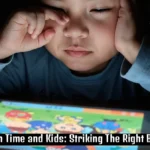Recognizing Anxiety and Stress in Children
In today’s fast-paced world, children are facing more pressure than ever before. Emotional well-being is as important as physical health, although many parents are concerned only about the physical one. Early detection of the symptoms of anxiety and stress can greatly contribute to the development of children into self-confident and emotionally stable persons.
Understanding Anxiety and Stress in Children
Defining and recognizing when anxiety is too much for a child is essential in helping a child manage their worry and lead a happy life. Instead, they tend to express their stress as behavioral change, physical, or withdrawal.
For reference, it is the norm that a child is generally nervous before a test or a performance. However, if the stress has become chronic or is affecting their sleep, eating, or social life, it may be a sign of other anxiety issues that have replaced, and need to be treated.
Common Signs of Anxiety and Stress in Children
The most frequent ones to monitor are as follows:
1. Physical Symptoms
Stress can be attributed to frequent headaches, nausea, or muscle tension. These physical complaints may be emotional in nature and have been ruled out as a medical problem.
2. Behavioral Changes
Sudden clinginess, refusal to attend school, irritability, or angry tantrums may appear. Some children develop abnormal silence or shyness, where they like to keep to themselves.
3. Sleep Problems
Sleep is an essential part of the development and education of a child, and, therefore, continuous sleep disorders should not be overlooked.
4. Changes in Eating Habits
Stress can decrease the appetite of some children, while others can use food to comfort themselves. Both extremes may be an indicator of your child being emotionally challenged.
5. Difficulty Concentrating
When your child all at once begins to have difficulty with concentration on schoolwork or when he appears to be so easily distracted, it may be that it is anxiety.
6. Avoidance
Avoiding some people, objects, or events may also be an indication of an anxious child. For example, a child who is afraid of failure may not even go to school or play sports.
Common Triggers of Anxiety in Children
All children are unique; still, some situations usually provoke stress or anxiety:
- Academic stress and weak performance
- Bullying or peer rejection
- Changes or family conflicts, e.g., divorce or moving
- Comparison or Exposure to social media or online comparison
- Fears regarding health or observing the sickness of a loved one
- A lot of workload and had minimal time to play or rest
How Parents and Caregivers Can Help
The following are some of the practical methods you can use to help your child emotionally:
1. Promote Open Communication
Provide a child with a safe environment where they can converse about their feelings without fear of criticism. Be a good listener and confirm their feelings, even when they appear insignificant to you.
2. Maintain Routine and Structure
Regularity also gives security to children. Reducing anxiety can be achieved by regular meal schedules, bedtime schedules, and planned activities.
3. Promote Healthy Habits
A healthy diet, regular exercise, and adequate sleep all help to reduce stress. Encourage screen time and outdoor activities.
4. Teach Relaxation Techniques
Expose your child to relaxing exercises, deep breathing, mindfulness, drawing, or listening to soft music. These are methods that can help them deal with intense emotions.
5. Model Calm Behavior
Parents tend to reflect on the emotions of their children. When stress is dealt with peacefully by the parents, the children will learn positive coping strategies through the example set by the parents.
6. Seek Professional Support
In case anxiety symptoms do not go away or get out of control, refer to a pediatrician, counselor, or child psychologist. Strong emotional difficulties can be avoided by early intervention.
The Takeaway
Childhood is not to be a period of stress all the time. Parents may utilize listening to early signs of anxiety and providing emotional support as tools to help their children manage anxiety. Anxiety is a major problem that needs to be recognized and addressed early, not only to enhance mental health outcomes but also to assist individuals in becoming resilient, confident, and optimistic about life.

